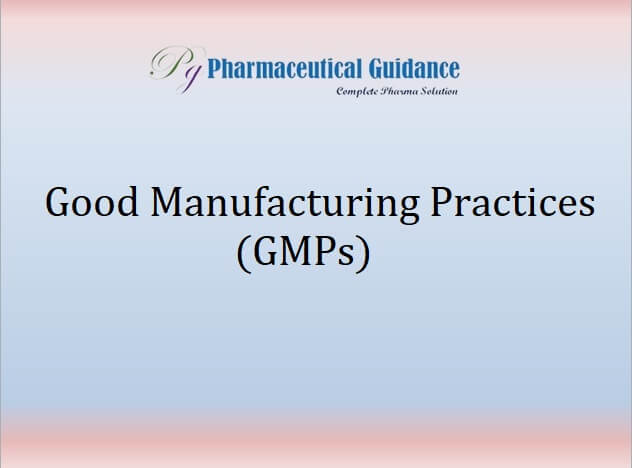Good Manufacturing Practices (GMPs)
CGMPs provide systems that assure proper design, monitoring, and control of manufacturing processes and facilities.
Good Manufacturing Practices (GMPs) are the basic manufacturing and environmental conditions required to produce pharmaceutical products. They ensure that ingredients, products, and packaging materials are handled safely and that pharmaceutical products are processed in a suitable environment.
CGMP regulations assure the identity, strength, quality, and purity of drug products by requiring that manufacturers of medications adequately control manufacturing operations.
CGMP establishes strong quality management systems obtains appropriate quality raw materials, establishes robust operating procedures, detects and investigates product quality deviations, and maintains reliable testing laboratories.
GMPs address the hazards associated with personnel and the environment during pharmaceutical product manufacturing and packing. They provide a foundation for any pharmaceutical product’s safety, quality, purity, and effectiveness.
As per ISPE – GMP regulations require a quality approach to manufacturing, enabling companies to minimize or eliminate instances of contamination, mix-ups, and errors. This protects the consumer from purchasing a product that is not effective or even dangerous. Failure of firms to comply with GMP regulations can result in very serious consequences including recall, seizure, fines, and jail time.
HVAC SYSTEM AND TEST FOR HVAC QUALIFICATION
GMPs Address:
Environment Condition control (premises): location, design, and construction of the building and its interior, equipment, water supply
Personnel practices and behavior: personal hygiene, hand washing, clothing/footwear /headwear, injuries and wounds, evidence of illness, access, and traffic patterns, and chemical use.
Receiving, handling, storage, and Distribution: Written procedure for inspection of transport vehicles; loading, Unloading, and storage practices; inspection procedures for incoming products; shipping conditions; returned and defective products; allergen control; chemical storage; waste management.
Pest control: monitoring procedures for the exterior and interior of the building and the use of pesticides for pest Control and fumigation.
Sanitation: cleaning and sanitizing procedures and pre-operational assessment.
Equipment maintenance: procedures describing preventive maintenance and calibration of all the equipment and instruments that can affect product quality and safety. (like- thermometers, thermocouples, metal detectors, scales, and pH meters).
Recall and traceability: procedures that ensure final products are coded and labeled properly; Incoming materials; in-process and outgoing materials are traceable; recall system is in place and tested for effectiveness (procedures for mock recalls).
Water safety: water quality and safety. Monitoring procedures for raw water, purified water, Water for Injection and steam, and water treatment procedures that ensure it is potable for use in product manufacturing and cleaning.
Change Control
Components of GMPs:
GMP has two main components:
Written programs and implementation. Both are essential for the success of your product quality and safety.
Written programs are all the policies and procedures required to meet the standards listed in each GMP program. These include:
Policies and procedures (Like- standard operating procedures (SOPs), and standard testing procedures (STPs))
Monitoring procedures record keeping (Like – how records are kept and handled)
Implementation OF (GMPs)
Involves conducting the activities required to meet the standards and monitoring them.
To ensure the policies and procedures in your program are performed as described, you need to train your staff in these procedures. Ensure:
Training involves everyone in the facility and meets all employees’ requirements
Training is recorded (ex: who was trained, by whom, date, and type of training)
Staff is retrained when you modify your programs
To monitor your procedures:
Review procedures and record your observations (Like like-environmental controls checklist, and monitor personnel practices).
Review records to ensure they are completed properly and that appropriate corrective actions are documented.
Inspect and test for effectiveness (Like- perform microbial testing on cleaned and sanitized food contact surfaces to check the effectiveness of your cleaning and sanitizing procedures).
OBJECTIVE OF (GMPs)
Guarantee high-quality products to the consumer. Delivering products free of all possible contamination.
GENERAL REQUIREMENTS
Avoid risks and possibilities of a mix-up at all stages of Mfg., labeling Pkg and testing
AHUs, the comfort of the personnel working, and regular monitoring of temp & humidity, Particle Count, DOP testing, etc.
Proper drainage system which prevents backflow. Avoid open channels and if provided must be able to clean and disinfect.
Building & Facilities
- Design and construction features.
- Lighting.
- Ventilation, air filtration, air heating, and cooling.
- Plumbing.
- Sewage and refuse.
- Washing and toilet facilities.
- Sanitation.
- Maintenance
Good Manufacturing Practices
A basic principle of GMP is that quality cannot be tested into a batch of the product but must be built into each batch of the product during all stages of the manufacturing process.
It is designed to minimize the risks involved in any pharmaceutical production that cannot be eliminated through testing the final product.
Ten Principles of GMP
- Design and construct the facilities and equipment properly
- Follow written procedures and Instructions
- Document work
- Validate work
- Monitor facilities and equipment
- Write step-by-step operating procedures and work on instructions
- Design, develop and demonstrate job competence
- Protect against contamination
- Control components and product-related processes
- Conduct planned and periodic audits
Do and Don’t of GMP
Hygiene
All employees working in direct contact with food, food contact surfaces, and food packaging must conform to hygienic practices. This protects against food contamination by microorganisms or unwanted material.
Hygiene and Communicable Diseases
- clothing
- hair
- personal habits
- hand washing
- personal effects and jewelry
- illness and disease
- injuries
- visitors
- training
Employees Shall be –
- Bathe daily
- No perfume, aftershave, or fragrant creams
- No jewelry
- No false nails or nail polish
- Fingernails should be trimmed short
- Use metal-detectable bandages covered with gloves
- No eating, drinking, or chewing gum
Hand washing
All employees must wash their hands thoroughly:
- when they enter food-handling areas
- before starting work
- after handling contaminated materials
- after breaks
- after using toilet facilities
Personnel
- Do not leave gloves, masks, etc. lying around while on break or at shift end.
- Crates, boxes, containers, or buckets must not be placed directly on the floor.
- Store brooms and dust pans at the stations provided.
Equipment, containers, and utensils
- Ensure that all containers, including those holding rework, are properly labeled and are kept covered.
Personnel Practices
- Do not lean, sit or step on product surfaces.
- Do not handle ingredients or products with either cut or infected hands.
- Do not engage in horseplay.
- Keep hand contact with ingredients and products to a minimum.
Sanitation
- Keep contact surfaces clean and free of contamination from tools, cords, cleaning utensils, machine parts, lubricants, and paper.
- Clean all spills promptly.
- Keep everything off the floor and the area clean and floors swept.
- Work areas should be cleaned regularly throughout the shift.
- Keep your immediate working area swept or dust mopped. Wipe or mop up spilled liquids promptly.
- Scrape the floor around the work area after completing a job.
- Leave your work area clean at the end of your shift.
Visitors to Production Areas
- Should always be accompanied.
- Must be appropriately dressed – hair coverings, booties over street shoes, gloves, sleeve covers, etc.
GMP Categories
- Premises
- Equipment
- Personnel
- Sanitation
- Raw Material Testing
- Manufacturing Control
- Packaging Material Testing
- Finished Product Testing
- Quality Control Department
- Records
- Samples
- Stability
Personnel
Appropriate education, training, and experience
A sufficient number of people
Receive GMP training sanitation
Sanitation Program to prevent contamination
Limit the sources and types of contamination
Cleaning procedures for facilities & equipment
Pest control
Environmental monitoring
Raw Material, Packaging Material, and Finished Product Testing
Each lot or batch of raw material is tested
Confirm the identity of the raw materials
Provide assurance that the quality of the drug in dosage
Samples of incoming materials are collected and tested before use
Approved test methods and specifications are used
Results must conform to specifications for release for use or sale
Transportation and storage records
Manufacturing Control
Written procedures are established and followed
Master formulae, manufacturing orders,s and packaging orders
Critical processes are validated
2nd person verification of activities
Self-Inspection Programmed
Quality Control Department
Quality Control Responsibilities
Testing of bulk components prior to use by production
Testing of finished product prior to release for sale
Stability program
Review batch records, labels
Release product, based on QC test results
Training, Auditing
Customer complaints
Records
Document all GMP activities
Use Good Documentation Practices (GDP)
Records must be readily available Good Documentation Practices
Documentation must be:
- Permanent (black or blue ink)
- Legible, clear, concise
- Accurate
- Timely, complete
Samples
- Retain samples of each lot of raw material and finished product for a specified period of time Stability.
- Establish the length of time in which the product meets all specifications.
- Monitor the drug for this period of time Sterile Products
- Packaged in separate enclosed areas by trained personnel using methods to ensure sterility.
Why GMP is important
- A poor quality medicine may contain toxic substances that have been unintentionally added.
- A medicine that contains little or none of the claimed ingredients will not have the intended therapeutic effect.
Some of the main risks are –
- Unexpected contamination of products, causing damage to health or even death.
- Incorrect labels on containers could mean that patients receive the wrong medicine.
- Insufficient or too much active ingredient, resulting in ineffective treatment or adverse effects.



